For this week’s post I am in Cloth Fair, a street just off West Smithfield with a name that goes back to the early days of the Bartholomew Fair held here when the fair was a centre for cloth merchants from across the country.
The street name and buildings indicate that when walking down this street we are following in the footsteps of those who have walked Cloth Fair for centuries, but all is not quiet what it seems along the street as I will show later in the post, but for now, it was tracking down the location of one of my father’s photos that took me to Cloth Fair, and to these buildings which he photographed in 1951:
The focus of my father’s photo was the taller of the buildings with the bay windows. These are numbers 41 and 42 Cloth Fair, the oldest residential buildings within the current boundaries of the City of London.
Construction of these buildings started at the end of the 16th century with completion early in the 17th, at a time when the area was within the walled compound of St. Bartholomew’s. They survived the Great Fire of London, and as my father’s photo confirms, they also survived the blitz.
The building on the right, number 40 was occupied by Mitchell, Inman & Co. a wholesale firm in the cloth trade, so even when my father took the photo in 1951 there was still a business specialising in the product after which the street was named. Mitchell, Inman & Co. produced a wide range of cloth based products, and in the London Evening Standard in 1866 they were advertising as “The cheapest house in London for Billiard, Bagatelle, and Card Table cloths.”
My father’s photo was taken from up against the church where, typically for photographing London today, there was building work underway, so my photo is from further along Cloth Fair, but shows the buildings are much the same today.
Ian Nairn described the houses as wonderful – “Wonderful not as a specimen of rustic late-seventeenth century architecture, not even as a very pretty building (which it is), but as an embodiment of the old London spirit. Chunky, cantankerous, breaking out all over in oriels and roof lights, unconcerned with academies, fashions or anything else other than shapes to live in. There was a lot of this in London after the fire; this is now almost the only example left.”
The buildings were almost lost early in the 20th century when they were classified as dangerous structures. The architects Paul Paget and John Seely bought the buildings in 1930 and carried out a very sympathetic restoration. They continued living and working together in number 41 and their success enabled them to purchase and restore many other buildings in Cloth Fair.
The following print shows 41 and 42 Cloth Fair in 1851 with shops occupying the ground floor of the building:
By 1930, 41 and 42 Cloth Fair had already survived other major changes in Cloth Fair. Up until the start of the 20th century Cloth Fair and the surrounding area included numerous crowded alleys with very unsanitary conditions. The Corporation of London Sanitary Committee condemned many of the buildings in 1914 and their demolition was completed soon after.
The state of Cloth Fair was frequently mentioned in newspapers. Cloth Fair and the Hand and Shears pub were part of the opening and administration of the Bartholomew Fair and the opening of the 1829 fair is recorded in the London Courier and Evening Gazette with “the usual formalities as they are ostentatiously styled, do not go beyond some such ceremony as that of the Lord Mayor and Sheriffs standing in a filthy lane, called Cloth Fair, whilst a Marshalman or Herald miserably reads a proclamation, enjoining such as frequent the fair to abstain from all proprieties.”
The British Museum has some photos of the alleys around Cloth Fair taken in 1877 by A. Bool for the Society for Photographing Relics of Old London. These photos (©Trustees of the British Museum) show ancient buildings crowded around narrow alleys.
The following photo shows not only the narrow alleys around Cloth Fair, but also how Cloth Fair has changed over the years. The photo shows a narrow alley. A small child is at the end of the alley and on the left are houses leaning over the alley to get a small bit of additional space for the upper floor.
Look to the right of the photo and there is a substantial stone building.
I found the above photos after I had walked along Cloth Fair, so I could not get a photo in the same position, however after looking again at my photos it was clear where the above photo was taken.
On the right in the above photo there are three arches at ground level. Above this, there is a roof, leading back to a higher stone wall with windows and drain pipes. Towards the end of the alley, the building on the right is higher still, with an angled roof.
Now look at the photo below and it is clear that the building on the right in the above photo is the side wall of the St. Bartholomew the Great.
The original photo was taken roughly were the furthest bollard is now located, looking towards the nearest bollard, which is roughly where the child was standing. Two of the three arches can be clearly seen, as can the roof above, the windows and drain pipes. Getting closer to the camera, the building rises a level with an angled roof, as in the original photo.
The houses on the left of the original photo were where the “Keep Clear” signs are on the road today. This alley was not Cloth Fair, but ran parallel to the church where Cloth Fair should have been, so how did this work?
Turning to the 1895 Ordinance Survey map provided the answer:
Cloth Fair can be seen running left to right across the map. Below Cloth Fair is St. Bartholomew the Great.
Look just above the church, and between the church and Cloth Fair, running half way along Cloth Fair is another row of houses with a narrow alley between the church and Cloth Fair. This is the alley in the photo.
The alley and houses have clearly disappeared since 1895, however that cannot be the full story otherwise there would be a much larger space today, where the alley, houses and Cloth Fair were located.
The extract from the map of the area today has the answer:
The angle of the route of Cloth Fair as it runs past the church to the right has been changed. In the 1895 map, the junction with Middle Street is slightly offset, today Cloth Fair runs straight into Middle Street. Cloth Fair today is also running parallel to the church.
The British Museum collection also has the following photo, which I believe is taken in the same alley, but this time looking in the opposite direction as to the photo above, now with the church of St. Bartholomew on the left of the photo. This is looking towards the where the alley exits onto Cloth Fair in the 1895 OS map.
In the photo below, the alley in the above two 1877 photos ran along the footpath on the left, and the majority of the road was occupied by the houses in the photo. The original Cloth Fair ran along the footpath and partly under the buildings on the right. In the above photo there is a building projecting out at the end of the low roof leading up from the bottom left of the photo. This is the entrance porch seen in the photo below with the black and white patterned roof.
So even along streets as old as Cloth Fair, we can never be sure we are actually walking along the route of the original street. Along this stretch of the street today we are walking along the old alley and where the houses once stood.
There are many other lovely buildings along Cloth Fair. This is the Rising Sun pub at Number 38. A pub has been at this location for a number of centuries. I can find newspaper reports mentioning the pub going back to the start of the 19th century, and the pub is (although not the same building), much older.
Cloth Fair would have been risky place to be in during the Bartholomew Fair. The are numerous reports of crimes in the area, many violent and plenty of thefts, including the following from the Rising Sun:
“On Monday se’nnight, some thieves during the busy period of the evening, it being at the time of Bartholomew Fair, broke into the upper apartments of Mr William Sawyer, of the Rising Sun, Cloth Fair, and carried off all the wearing apparel, some sheets, and two watches, &c., to the value in the whole of £60 with which they decamped, and have not yet been discovered”.
This is number 43 Cloth Fair, also on Cloth Court,
The building was home to Sir John Betjeman from 1954 for 20 years. He moved into the building after meeting Paul Paget and John Seely and seeing their restoration work in Cloth Fair. The building is now owned by the Landmark Trust.
Although Cloth Fair has lost many of the alleys that lined and led off from the main street, there are still a few that remain to give a limited sense of what the area was once like.
The buildings that line Cloth Fair are fascinating, as is the history of the street and association with the Bartholomew Fair, however after finding the photos of the alleys and the alley that once ran along the edge of the church, it was being able to place the alley, and the realisation that streets I thought were original have slightly changed their route over the years that was really pleasing.
It is these little details that make walking London’s streets so interesting.

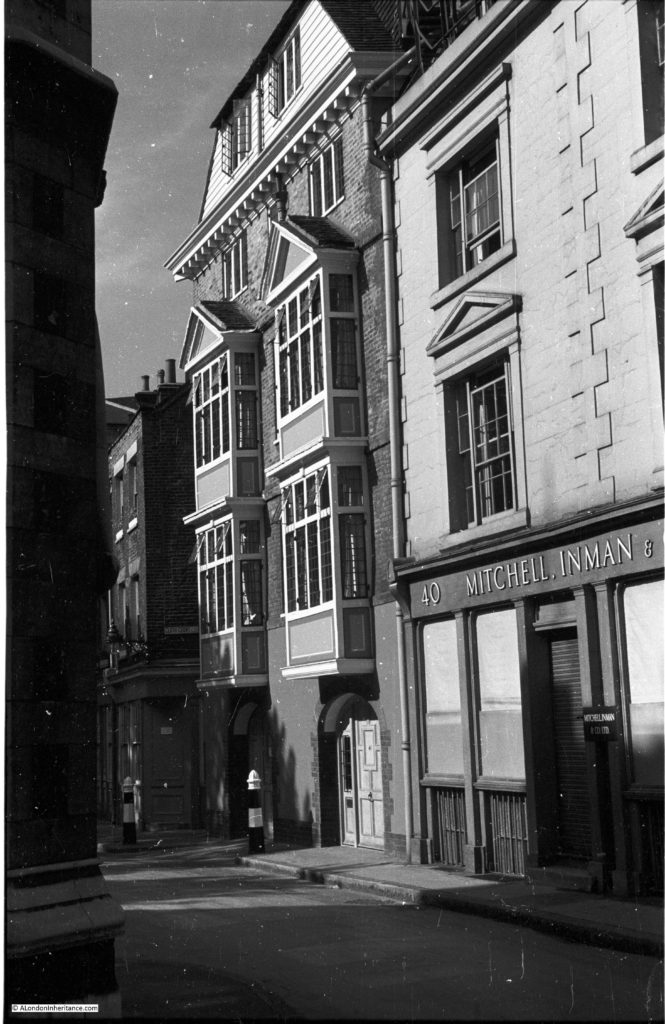

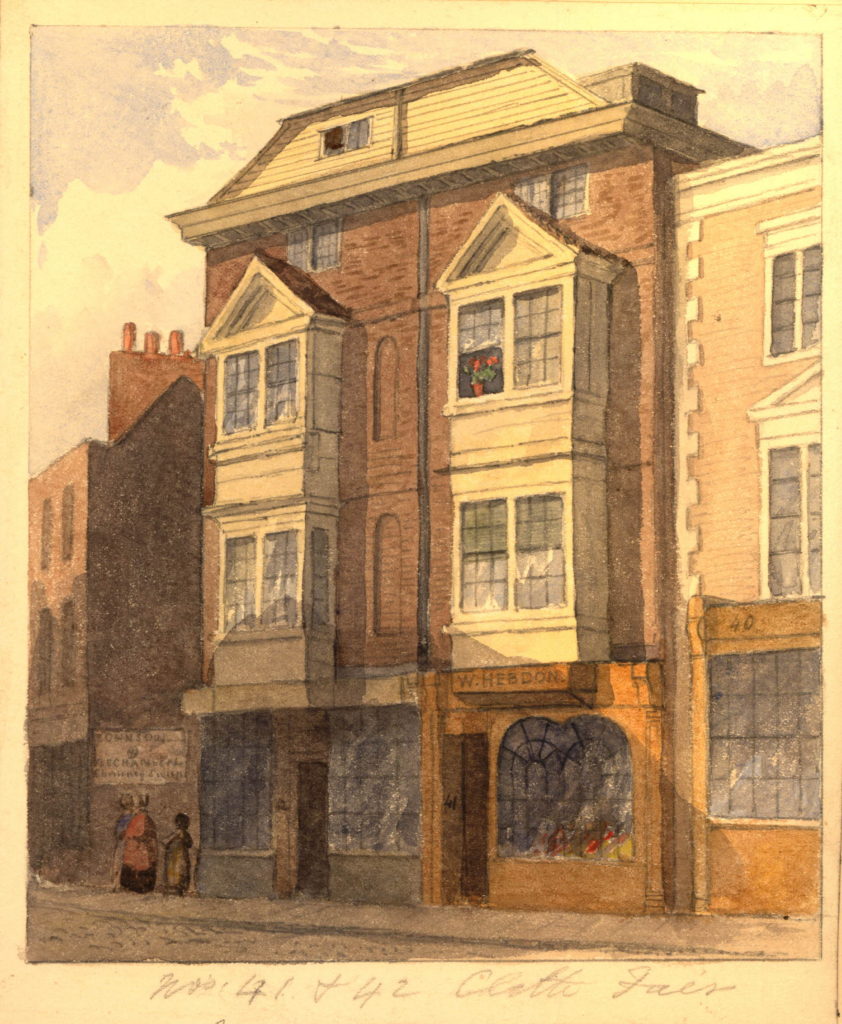
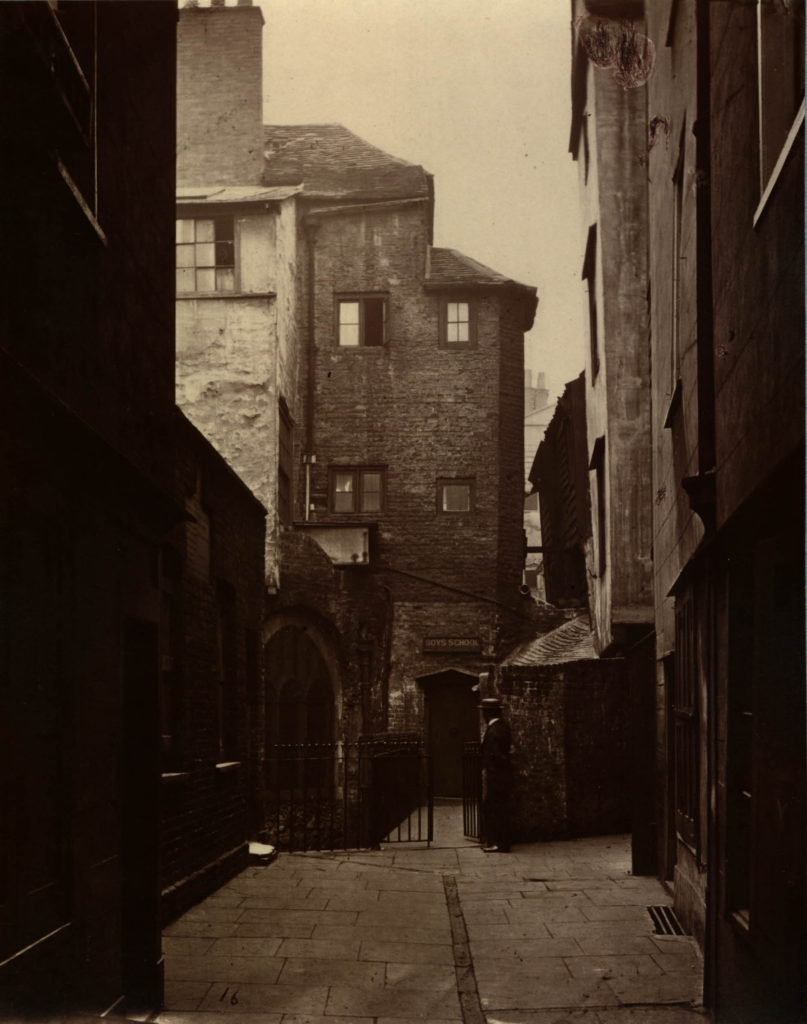
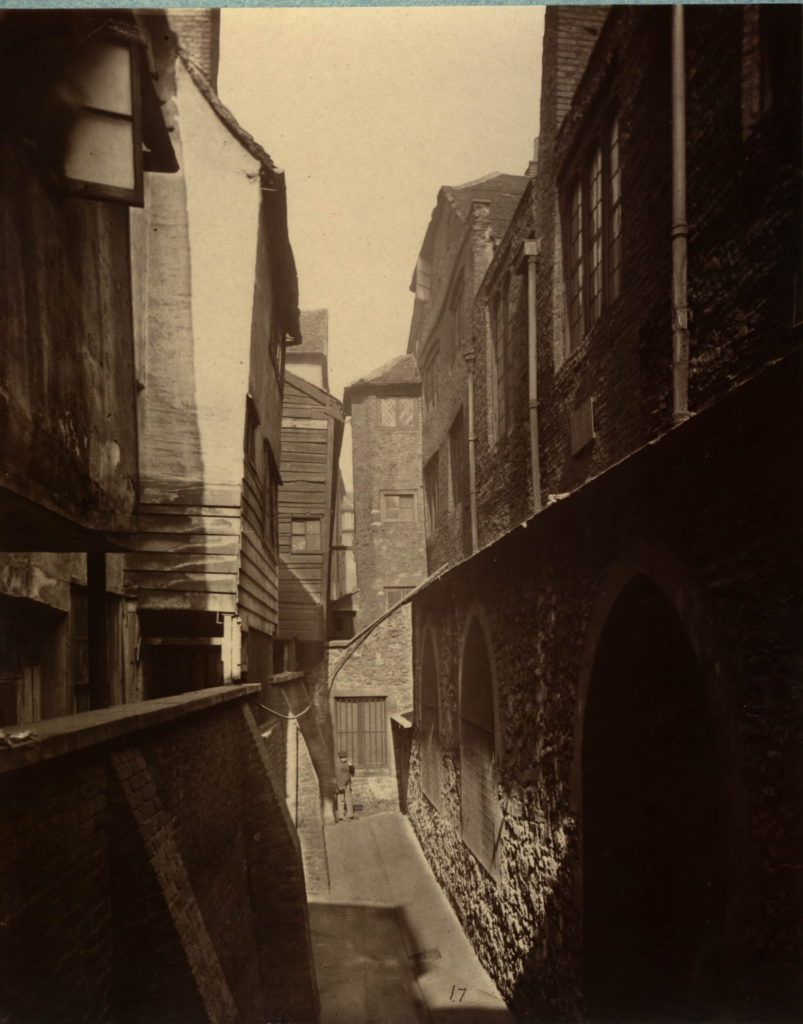
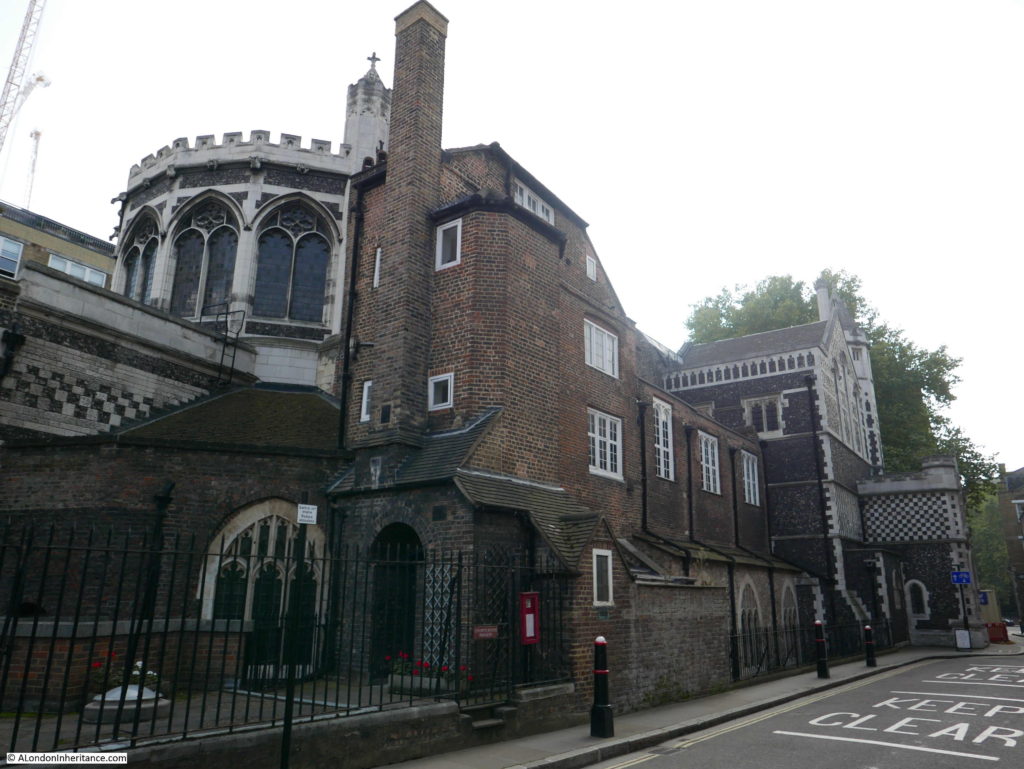
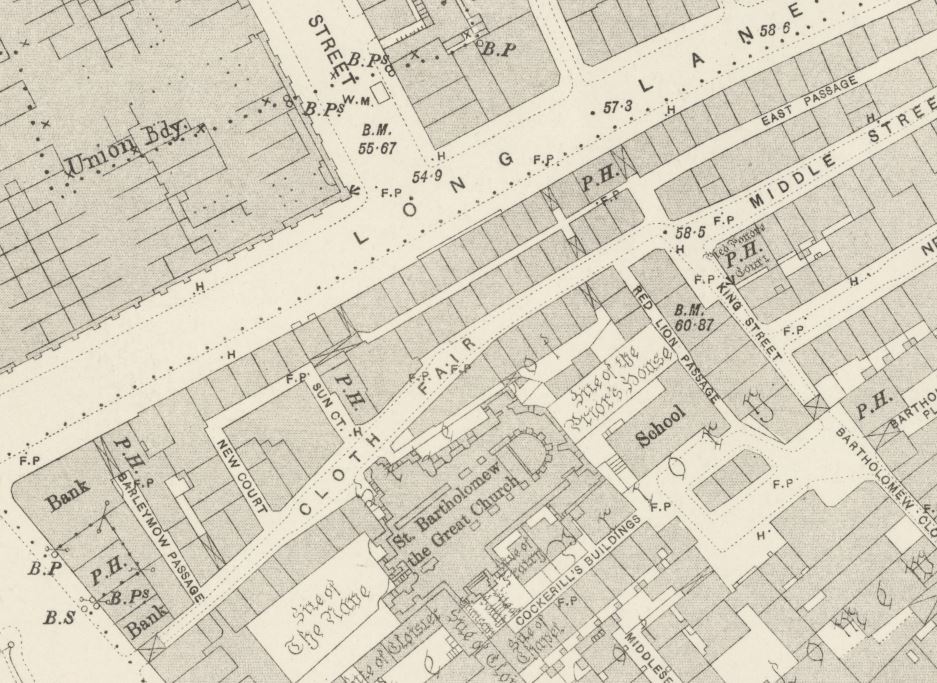
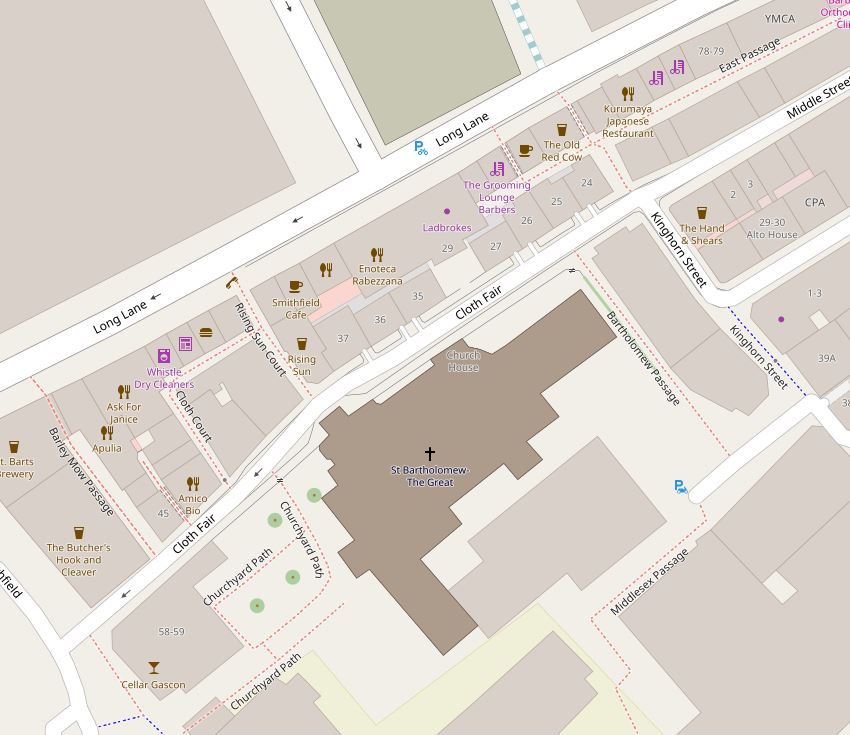
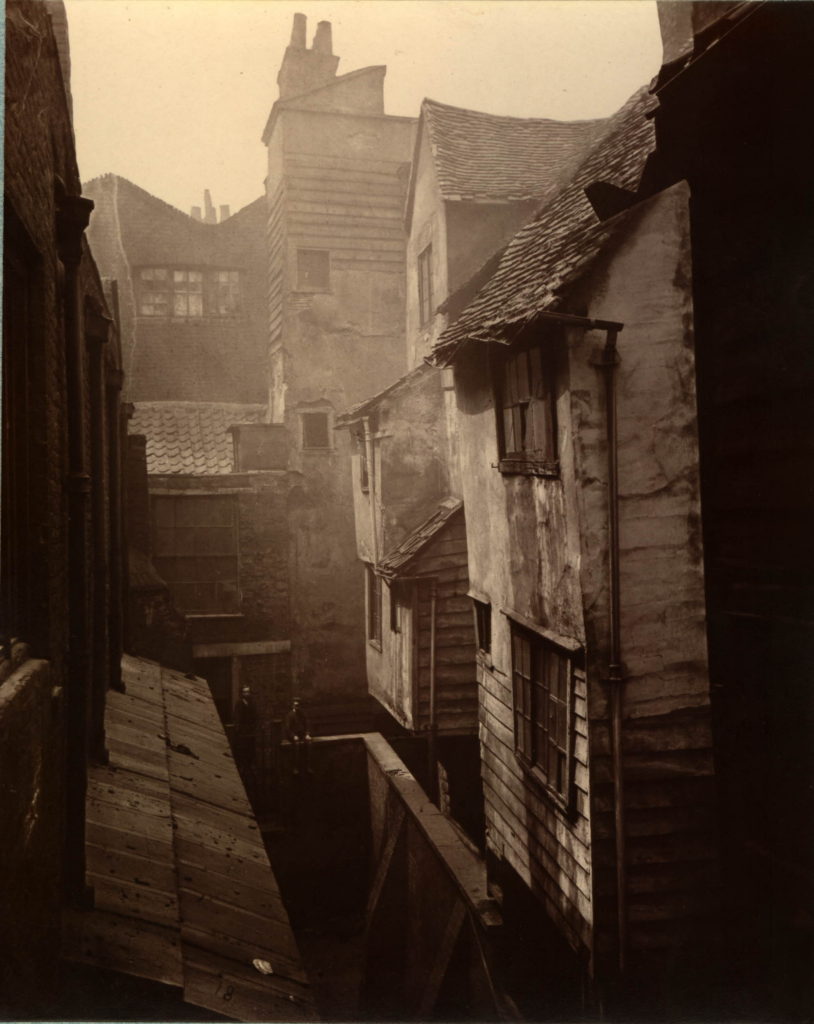
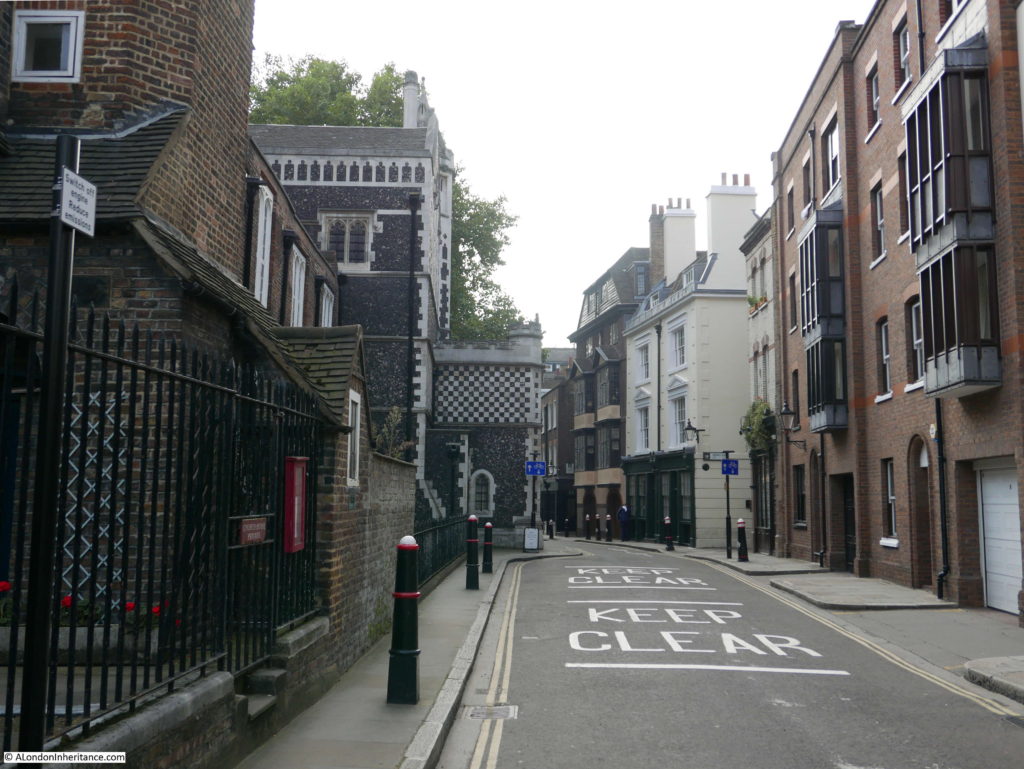
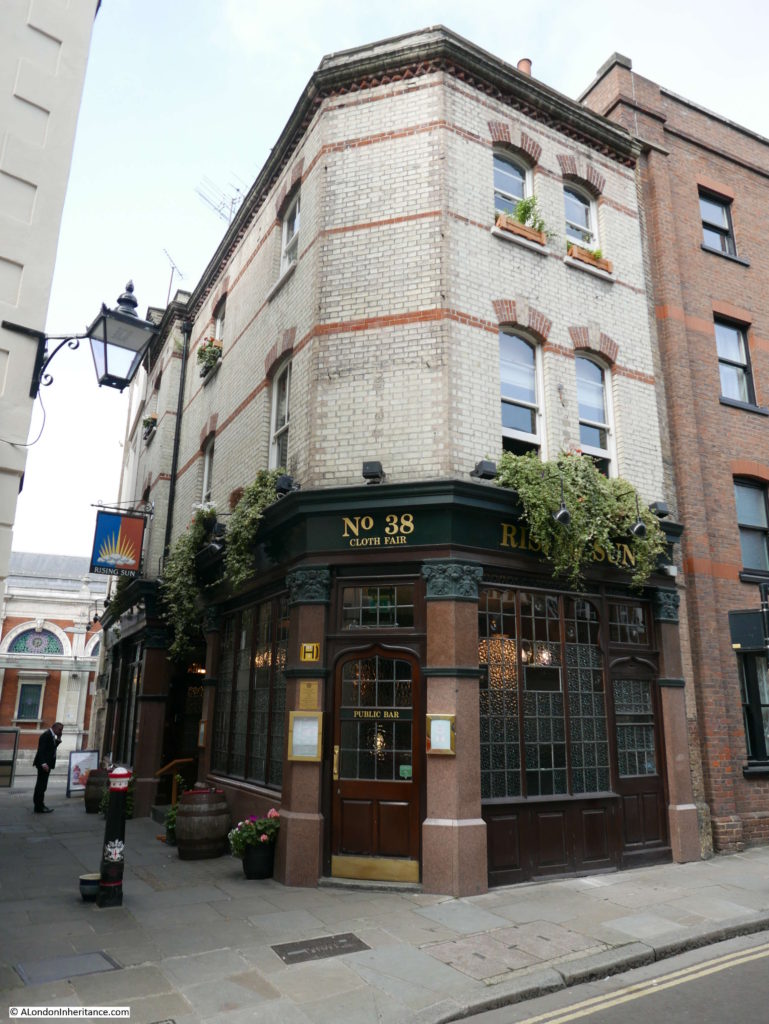
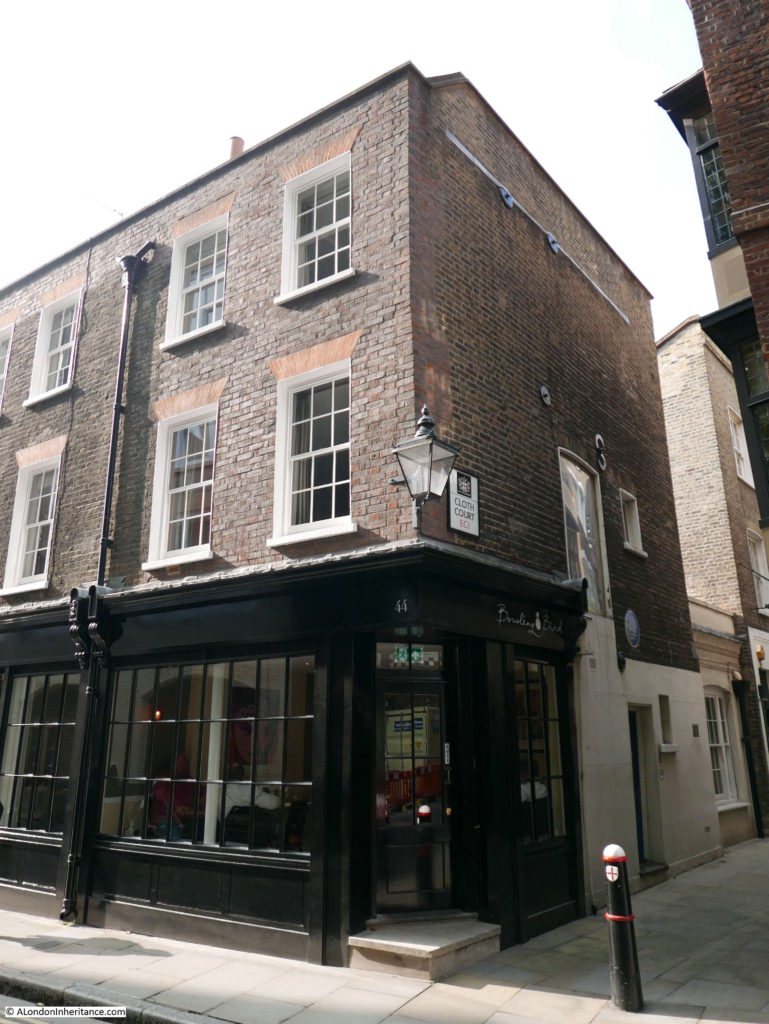

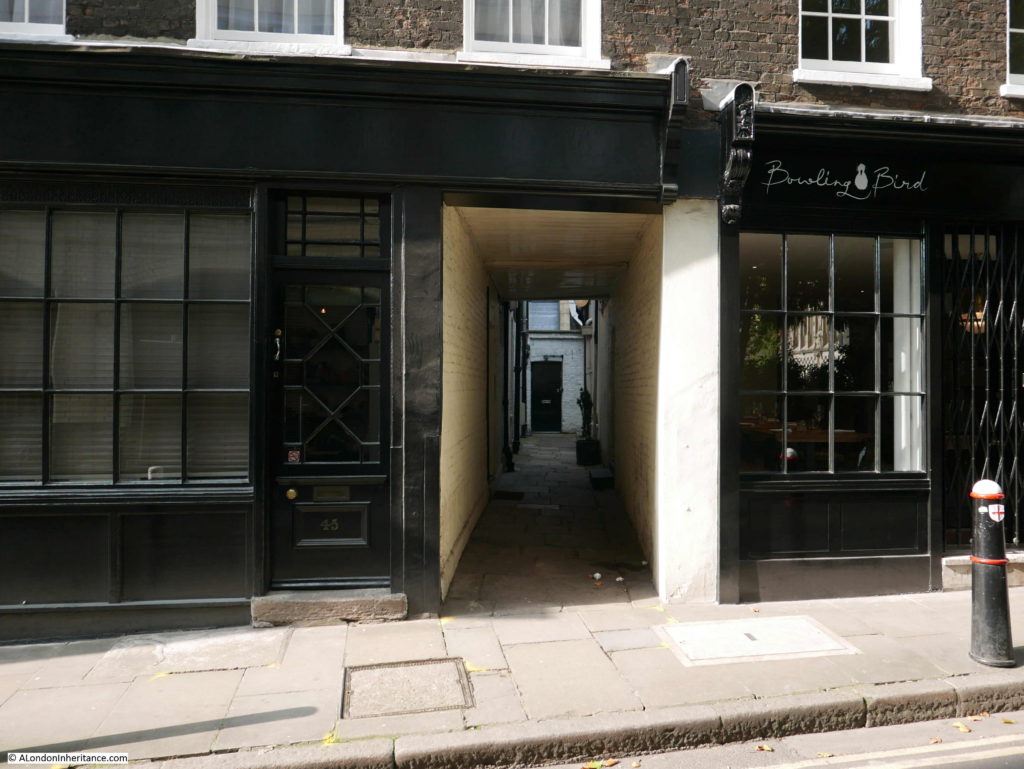
Fabulous!
Yes, thank you for such an interesting and well researched article. We stayed in the flat next to John Betjeman’s in the late ‘90s. It too is now owned by the Landmark Trust. We got a strong feeling for the old City living there for a few days.
Dont you just love london.thank you was very interesting.
I do love walking around the old parts of my London town. I was born in Enfield. The real suburbs. Not as many interesting places to wander. But i’ve been living in Covent Garden the last 10 years. A much more interesting place to let you feel the history of this fascinating city.
Plus. I do love going to old pubs. Not these awful ‘ghastly gastro’ pubs. The Rising Sun you photographed is a lovely old Sam Smiths ‘boozer’. I love the Cheshire Cheese in Fleet St & the White Horse in Soho. It’s great that they still have this tradition going. Buy a cheap drink, a bag of crisps & you can sit & talk in an ‘inebriated’ fashion and think of all the other thousands of people who have sat in your chair before you!
Fascinating piece of research. Many congratulations. I envy you living in Covent garden. Look forward to reading more of your articles
You are doing a tremendous piece of work with your research. I love reading your blog.
I Really admire your detective work with maps.
Thank you for your interesting piece on Cloth Fair. It is a street that my distant cousin Alban Leaf would have known. Cousin Alban was a warehouseman who lived and worked in Bartholomew Close from about 1710 to 1756. I’d love to pin down the location. Any suggestions?
What a great name for an ancestor. Can I recommend the amazing site collage.cityoflondon.gov.uk as a place to find remarkable images of Bartholomew Close and a place to start your search. There is also an excellent resource called British History Online with a relevant document about the development of Bartholomew Close. Best of luck!
Hi
If you get extracts from the census for those years this will help.
There is also an excellent website that compares street names in the past with how places are named today in London
Good luck
I’ve said it before but need to say it again: thank you for your wonderful blog! It’s always fascinating and a pleasure to read!
Brilliant piece of City history! I came to work in Smithfield 1963 and have a long association with this area ever since. My daughter now works in Long Lane and has inherited my interest in this historical area.
Keep up the good work!
What a wonderful bit of sleuthing, David. You are a magician with maps!
In your photo of the corner of Cloth Fair & Cloth Court, I hope I see that the bricked up window with “The Sailor’s Home Coming” is still there. Another reason to be grateful to Seely & Paget.
A lovely corner of London not often seen, I joined Midland Bank West Smithfield in 1976 (now I believe a bar – The Meat and Cleaver) and many a lunch hour was spend either in the Barley Mow or the Hand and Shears, then later the Rising Sun after it had reopened. The Barley Mow was known as our “sub branch” and customers would often look for us there. I love the architecture around there and was always told to look up and not just eye level as the buildings sometimes had more to offer up high. Thank you for such great pictures.
Love this one! Cloth Fair is my favorite place in London. I have stayed in both of the Landmark Trust properties (45a and 43 Cloth Fair), and highly recommend them. Visit the Landmark Trust website for pictures of the interior and some additional history. Both look over the churchyard of St. Bart’s, and Smithfield Market is just around the corner. In the evenings and on weekends, it is very quiet, and sitting in the churchyard or walking through the alleys is very eerie. It truly feels as though one has gone back in time by several centuries.
once again such an interesting report, you are blessed with your fathers photos, what a piece of modern history! I will call into Cloth Fair when I next visit London. many thanks
This was great. The missing houses that were removed at the beginning of the 20th century have long been something I have wished to see for myself. A shame they were not retained and restored.
Thank you for the details of Cloth Fair.
According the the 1851 Census No. 37 Cloth Fair was the home of my great great grandfather Herbert Davies and his family.
It is interesting to discover from your article what is was like about that time, it would appear a tough place to live. So different to here in New Zealand.
Ron Curwood
This is an outstanding piece and I thank you for it. Some years ago I spent about three weeks in Barts Hospital undergoing high-dose chemotherapy treatment so all the buildings, the surrounding streets and alleyways hold such intense memories for me – initially of fear and despair but ultimately of hope and health (I’m still here!). The area has an often very dark and cruel history but as your blog shows there are fascinating points of interest at every turn. All your pieces are totally absorbing.
A corner of London I never knew existed – I seem to have walked all around it over the years. Excellent forensic work with photos and maps as usual – always gets my interest.
Thank you for posting this information, it’s very helpful. My great grand mother run a florist shop at 44 Cloth Fair and lived above in 1939. I’m trying to find more information and pictures, have you come across any info of a florist shop then?
Thank you
Claire
My grandfather had a tongue curing shop at 44a at new court cloth fairand was known as tongue bethneycirca1910-1940.Recently l was in the area and found at the back of 44 was an alleyway with door that took up to the curing shop.Number44 is awinebar know.If this is the same place the shop was turned nto a flat and the door at was filled in at the same time.
The Cloth Fair area, with magnificent Great St. Bart’s, is easily my favorite part of London. I stay in the area when I’m working in London, and love walking around the little alleys and passageways. I am concerned that the area will change significantly due to the large new residential development, but as your post shows, there has always been change! Thank you for your outstanding research, and for sharing it in such a fascinating way.
Wow! Who knew. I cycle down Cloth Fair regularly (to get off Long Lane) and sometimes drink in the Hand and Shears. This is totally fascinating, thank you.
I had the most wonderful experience roaming around Cloth Fair.In the 1881 Census my Great,great grandfather George Alfred Maxwell a tailor was residing at no 12 Cloth Fair with wife Ellen and daughters Alice and Ellen both of whom were baptised at St.Bartholomews.I had a beer at the Hands and shear pub but the barman had no knowledge of the history of the area.Where about would no.12 have been located in 1881?.I live in Cape Town South Africa and am proud of my connection with Cloth Fair.
Another fact about Cloth Lane was Richard Newsham’s pearl button factory in the 1700’s were he developed and manufactured the Newsham fire pump which gained much notoriety and was a first of it’s kind and widely sold even to America. Little seems to be known of the man and his family and the factory I presume would be long gone..
David, my very distant cousin Alban Leaf, who lived on nearby St. Bartholomew Close, was appointed by the church wardens on August 12, 1730, to purchase a fire engine. Perhaps it was from his neighbour Richard Newsham? Source: Parish chest records of St. Bartholomew the Great, on microfilm from FamilySearch.org
Thanks for a fascinating read. I’ve walked around the area and like others have enjoyed its history. But until this week I didn’t know that I actually had ancestors who lived in Cloth Fair. The 1871 census shows William Roberts and his wife Lucy (my 3x Great Grandparents) living at 11 Cloth Fair with their five children. But there are also two other families living at number 11, 14 people in all. William was a butcher (presumably at Smithfield Market) and the family had moved from near Colchester Essex between 1865 and 1870. The pictures from 1877 give me a real feeling of what their living conditions were like, thank you.
I am pretty sure I know the location of the 4th picture. As I pass through Cloth Fair at least 5 times a week, I will grab a photo and see whether I can line my one up exactly the same.
I used to work in 42 Cloth Fair. The building inside is beautiful and very of its time. A little bit higgledy piggledy with wonky floorboards etc. My very favourite thing was in those windows up on the first floor, there are lots of names and dates scratched into the small window panes, dating back hundreds of years and I was told that is where the rich people scratched their names in the glass with their diamonds!
I was a student and houseman at Barts Hospital in the late 1950s. The Red Lion pub, then in at state of great disrepair, must have been leased by the hospital because it was the repository of very old clinical notes. However the flooring was said to be so unstable that no one would go after them. Thus if any notes could not be traced, for whatever reason, a note came back “At the Red Lion” and they were irretrievable for ever more
Apologies for comment sent on08/03/19. Senior moment- For Red Lion read Rising Sun, my local is Red Lion and must have taken over.
“The British Museum collection also has the following photo, which I believe is taken in the same alley, but this time looking in the opposite direction as to the photo above, now with the church of St. Bartholomew on the left of the photo. This is looking towards the where the alley exits onto Cloth Fair in the 1895 OS map.”
The photo is taken from inside Barts the Great. To the left of the “keep clear” signs on the road is a gate and entrance in the north side of Barts the Great. This leads to the verger’s office and two floors above accomodation for the verger. The old photo is taken from inside of this stairwell and the short sloping roof on the left is above these arches here https://goo.gl/maps/1r69JjuVfHhsYtsJ8.
This is really interesting, thank you. One of my ancestors was a tailor and lived in Middlesex Passage, Cloth Fair in the mid 19th century.
Lovely piece, well done. I was a bike messenger in London 20 years ago and Cloth Fair was 1 of my favourite places of peace and quiet to hide away from the maddening busy’ness of the surrounding streets.
Yes wonderful articles! Can you tell me please the location where St Bartholomew’s Fairtook place?
I lived at 41 Cloth Fair in the 60’s when the house was owned by Seely & Paget. Also my father signed the window with the diamond pen. I wonder if someone has pictures of the Queen Mother visit to the house? Probably I was the little girl who greeted her. I now live in Italy, but I have a lot of memories of the house, the services in St Barth church, the meat smell in Smithfield market and resting in the Rotunda garden. Thanks to Fiona Rule for her interesting writing “The oldest house in London”.
Hi Sandra! Ohhhh….maybe we followed on from you? My mother and step-father lived there in the late 60s. My mother was house keeper to Paul Paget and they lived in the flat at the top of the house…I used to throw my toy animals from the windows onto the heads below…
My mother had a near-miss with smoking turkey fat one Christmas, and half London Fire Brigade rushed to rescue the ancient house – I remember exciting scenes of fire fighters and hoses everywhere.
My 4th great grandfather William Jack surgical instrument maker is listed as residing at 17 Cloth Fair in the 1839 Trade directory. It’s wonderful to be able to see what that area looked like. Thankyou for this info.
Thank you for your blog. It is lovely to see images of where my family were born and grew up. My Great Grandfather was a Chimney Sweep in 1901 he was lodging with the Vials in Red Lion Passage and then by 1911 he was residing in Middle Street. His 13 children were born in and around Cloth Fair – Middle Street, Newbury Street, East Passage. Sadly in 1903 my Great Aunt died at the age of 2 weeks at 79 East Passage, as I can well imaging 1 room with several family members living and sleeping together, my great grandmother feill asleep on her. Thank you for allowing me to see what it would have been like living in the area at that time. I am obviously very interested in the alleys and streets in the area and the work of chimney sweep, type founders and other such trades.
This is a very interesting article. My gt.gt. grandfather Matthew Weekly and his wife Ann were living at 42 Cloth Fair in 1853 when their fourth child was born. He was a solicitor’s clerk. They moved there sometime after 1851 and by 1856 they were living in Wandsworth. I would love to know about his time there and where he was employed.
Fascinating post, thank you! I found an 1890 photograph of the junction with Middle Street as it used to be before Cloth Fair was straightened, which shows just how narrow Cloth Fair was at the time. https://www.theundergroundmap.com/image.html?image=2357
I was doing some family history and came across a household of 16 living at Cloth Fair, St Bartholomew the Great. No street number was provided. I didn’t know what was meant by Cloth Fair until nor reading your research. Thank you
My grandad , Henry John Martin was born in Cloth Fair in 1892 , this and other places nearby give a real sense of history , I myself was born in Barts and lived in 58 Rawstorne Street until my mid teens so often explored this extraordinary part of London and viewed it as mine . Seeing Smithfield back in the day was a journey 200 years back in time. Ideal !
My relatives Henry Pearson white, wife Ellen White ( nee Barrett) and children lived at Church house, cloth fair EC1 in 1930..
Does church house still exist today ?
Any information would be appreciated as on your earlier map it looks like it is attached to the church so possible still exists..
Wonderful to read this article and to see the old photos of Cloth Fair. My husband and I both worked in Middle Street from 1968 to 1972. I worked in the offices at 23 Middle Street for J.C. Wetter & Co. Ltd. a meat machinery company and my husband was a delivery driver for Laurie’s Butchers, which was opposite. Mr. Wetter also owned the property opposite St. Bartholomews Church, which has now been converted to luxury apartments. We used to call it the ‘prefab’ it was just a yard and storage area at the time, hidden behind corrugated fencing. Thank you for bringing back some lovely memories for my husband and I.
I’ve stayed numerous times in 45a Cloth Fair (Landmark Trust property) and am always fascinated by the ancient area. Thank you for such detailed information about the street. For any visitors to the area, St Bart’s Church is well worth a visit (and is the church where Hugh Grant married “Duckface” in Four Weddings and a Funeral.
My wife’s 5x Gt Grandparents lived in Cloth Fair in 1778. On the 15 July that year Sarah Westfall (nee Hubbins) was called to the Old Bailey to give evidence regarding a robbery. She is sworn as saying “I live in Cloth Fair; Alexander Carleton lodged in the garret at my house: on the fourth of June he came home at half after ten at night; he said he must go out again for half an hour, I sat up for him till twelve o’clock, he came in again at twelve; I saw no more of him till eight next morning, he went into his own room then, and went out again immediately, he did not come in in the night, I locked and bolted the door myself, and therefore I am sure he did not come in that night; he lodged in the garret, when he came in at eight in the morning he had a parcel under his arm; he went up stairs and came down immediately, he said if any body called for him he should be in again very soon, for he should lie down to take some sleep for he had had none all night.”
Would anyone have any information on Albion Buildings in Cloth Fair my grandfather was born there in 1889 his father was a tailor.
Very interesting article and research, my Grandfather was born at 1 Red Lion Court, Cloth Fair in January 1893
My grandad was born in 22 Albion Buildings Cloth fair. Can anyone give any info on this. Please
Here is a picture
https://m.londonpicturearchive.org.uk/view-item?i=40854&WINID=1702756326552
Just happened upon this macabre article from the Oxford Journal dated 16 July 1757 :-
“Last night about Eleven o’Clock, a Fellow of the Rope Dancing Kind was discovered in Smithfield, at the Corner of Cloth Fair, sliding down from the Top of the House, by a very small Rope, Part of which he left behind him – It has not yet been discovered whether ’twas a Love Affair, or a thing in House-breaking Business that occasioned hisself to much Pains to run the Hazard of breaking his Neck.”